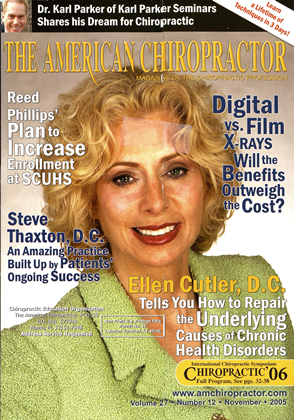Part One: For the Mother We can certainly see the need for regular chiropractic care throughout pregnancy—the varied postural distortions with weight gain and an increase in the hormone relaxin bring many mothers-to-be into our offices seeking help for these normal and often uncomfortable adaptations. It is within our scope of practice to assist the mother post partum in regaining spinal stability with the chiropractic adjustment and recommendations for postural positions she will encounter with her new baby. Carrying the new baby The first consideration is carrying the baby. Because all parents are using car scats these days, they have resorted to using these seats as carriers as well. Almost all parents will leave the child in the car scat to carry the baby into the office, store, house, etc. When parents come into your office carrying their child in one of these carriers, point out the imbalances these are causing them by side carrying this heavy load. This constant repetitive distortion of the parent's spine can adversely affect the spine. Usually, the parents carry the infant to one side, causing increased stress to their spinal structures. As a doctor of chiropractic, you will find neck strains, upper thoracic tension and sacral distortions associated with incorrect or repetitive baby carrying. To help avoid these common discomforts, I suggest to the mother that the car seat is for the car and that they use alternate types of carriers to transport their babies outside of the car. One option is the age-old method of simply carrying the baby in one's arms. Although most practical and easiest to implement, many mothers will tell you that they have a tendency to carry their babies on one side or the other because it is simply more comfortable that way. To avoid this one-sided propensity, I offer the options of "body carriers" or "baby wearing". These include a wide variety of carriers: wraps, slings, pouches, front holders, side holders, back carriers. Whereas most offer numerous benefits to the mother—baby weight balancing, free hands, and slow and consistent adaptation to the baby's weight gain—there still remains the consideration that each individual carrier places the baby in one particular position on the mother and, therefore, has the potential of cumulative repetitive stress on the mother's spine and nervous system. With this important insight in mind, I offer parents the knowledge of various baby carriers available and that they purchase several variations of carriers to accommodate their child's needs to be held as often as possible. Breastfeeding postures Another source of spinal stress in the new mother is compromised breastfeeding postures. In addition to lying down with the baby, the most common posture for breastfeeding is in the mother's arms with a tendency to slump forward. This distorted posture for the mother may cause upper thoracic sprain/strain, cervical and lumbar stiffness and resulting curve compensations for all areas. The best solution to avoid these repetitive postural distortions is to advise the mother to purchase a breastfeeding support pillow and use it as often as possible. To find out more about choosing carriers and breastfeeding support pillows, visit www.icpa4kids.org/research/chil-dren/babywcaring.htm February 12-18, 2006 JjtltS PANAMA Dr Jeanne Ohm instructs inlernaliomillv on the topic "Chiropractic Care for Pregnant Women and Children ". She is executive coordinator of the International Chiropractic Pedialric Association ami can be reached via their website at www.icpa4kids.comM
 View Full Issue
View Full Issue






